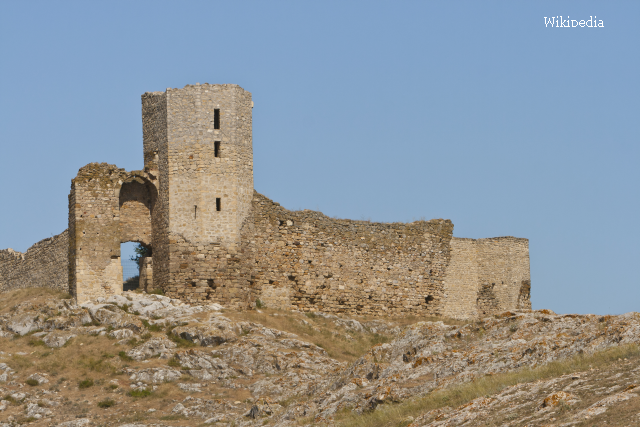Citadels along the Danube’s Romanian segment
The river Danube is a waterway trade route, also lying at the crossroads of various cultures. Its banks have also been home to a string of thriving settlements. For instance, along the river’s Romanian section, from times immemorial various citadels cropped up, in the Danube Delta or on seacoast, but as well as in various points, all along river Danube’s downstream section, where the river flows into the sea. The role of such citadels was mainly a military, defensive one, yet quite a few of those citadels had grown into real towns. In the Danube Delta, there are such citadels as Enisala and Halmyris, but before we reach the Delta, we might as well come across the ruins of other ancient citadels. Speaking about such citadels, here is the archaeologist Raluca Iosipescu.

Christine Leșcu, 26.07.2014, 17:41
The river Danube is a waterway trade route, also lying at the crossroads of various cultures. Its banks have also been home to a string of thriving settlements. For instance, along the river’s Romanian section, from times immemorial various citadels cropped up, in the Danube Delta or on seacoast, but as well as in various points, all along river Danube’s downstream section, where the river flows into the sea. The role of such citadels was mainly a military, defensive one, yet quite a few of those citadels had grown into real towns. In the Danube Delta, there are such citadels as Enisala and Halmyris, but before we reach the Delta, we might as well come across the ruins of other ancient citadels. Speaking about such citadels, here is the archaeologist Raluca Iosipescu.
Raluca Iosipescu: ”A notable citadel is the one in Isaccea, Noviodunum, a settlement with a long-standing history, which played a major role during the Roman colonization. It also served as a harbor for the Roman army. It had the status of municipal city. It had actually existed prior to Romans’ arrival in the region. Its name does not have a Latin origin, actually. It continued to exist during the Byzantine period, when it became an important religious center. Later on, and that also due to its very good position on the Danube, Noviodumum continued to exist, which ended with a Turkish citadel being placed in the region.”
While going upstream we reach the citadel of Braila, where archeological research unearthed a series of Ottoman fortifications. Also in the region, but this time around following road taking us from Tulcea to Galati, lies the village of Garvan, the place where the citadel of Dinogetia used to stand.
Raluca Iosipescu: ”It is a very impressive citadel, thanks to its dimensions, with very thick walls, big towers, with important constructions that had been discovered on the premises. It has been archaeologically researched for a very long time. If we continue to sail upstream along the Danube, we reach yet another very important citadel, the one in Harsova, lying in an important trade hub and being also inhabited from the Neolithic age. It used to be inhabited uninterruptedly until the 19th century, when it was destroyed in the Russian-Ottoman wars. Period photos show an impressive wall, known as the Genovese wall, which closed the entrance to the harbor, having several superb gothic vaults. All those citadels had been inhabited from times immemorial, which speaks about the fact that they were very well-placed, lying at the crossroads of several trade routes, where you passed from Dobrudja to Walllachia, also being proof of the fact that those areas were very prosperous.”
If we carry on sailing further upstream from Harsova, right opposite to the Bulgarian locality of Silistra, lies the Păcuiul lui Soare citadel. Speaking about the citadel, here is the archeologist Sergiu Iosipescu.
Sergiu Iosipescu: ”Paciul lui Soare stands out because it is Romania’s only Byzantine citadel, and was built in the 10th century by emperor Ioan Tsimiskes, and was the harbor for part of the Byzantine fleet. Unfortunately, around one seventh of it has been preserved to this day. The thing about Pacuiul lui Soare, which is something you can still see today, and which is unique, is a harbor with stone platforms flanked by towers, a pier having its entrance gate towards the city lying in the middle of the citadel. And that was something extraordinary for its time. No such other archeological evidence has been preserved. Sadly, even much less has been preserved of the Byzantine part of other citadel, the one in Giurgiu, This, as well as the following citadel, the one in Turnu Magurele, is closely linked to the history of Wallachia in the Middle Ages, in much the same way as the other citadel, lying even further upstream, the one in Turnu Severin. With the citadels lying in Clisura Dunarii, we emerge out of the river’s Romanian segment. Unfortunately, Giurgu as well as Turnu Magurele, but also Turnu Severin, had their own problems the moment the Ottoman rayahs were dismantled, and when the stone they were made of was used to modernize small towns.“
Today the restoration process for quite a few of the citadels along the Danube is still in its early stages, and therefore the citadels are much less capitalized on. Yet their history fully deserves to be known and their ruins are well worth visiting.






























